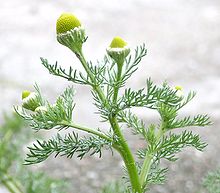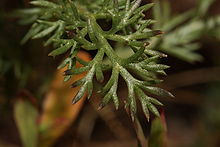- Matricaria discoidea
-
Matricaria discoidea 
Pineappleweed Scientific classification Kingdom: Plantae (unranked): Angiosperms (unranked): Eudicots (unranked): Asterids Order: Asterales Family: Asteraceae Tribe: Anthemideae Genus: Matricaria Species: M. discoidea Binomial name Matricaria discoidea
DC.Synonyms Artemisia matricarioides auct.
Chamomilla suaveolens (Pursh) Rydb.
Lepidanthus suaveolens (Pursh) Nutt.
Lepidotheca suaveolens (Pursh) Nutt.
Matricaria matricarioides auct.
Matricaria suaveolens (Pursh) Buchenau
Santolina suaveolens Pursh
Tanacetum suaveolens (Pursh) Hook.
Source: NRCS,[1] GRIN[2]Matricaria discoidea, commonly known as pineappleweed, wild chamomile, and disc mayweed is an annual plant native to North America and Northeast Asia but which has become a cosmopolitan weed. It is in the family Asteraceae. The flowers exude a chamomile/pineapple aroma when crushed. They are edible and have been used in salads (although they may become bitter by the time the plant blooms) and to make herbal tea. Pineapple weed has been used for medicinal purposes, including for relief of gastrointestinal upset, infected sores, fevers, and postpartum anemia.
Contents
Description
The pinnately dissected leaves are sweet-scented when crushed (Fir Island, Washington).
The flower head is cone-shaped, composed of dense-packed yellowish-green corollas, and lacking ray-florets. The leaves are pinnately dissected and sweet-scented when crushed. The plant grows 2 to 16 inches (5.1 to 41 cm) high. Flowerheads are produced from May to September.
Distribution
The plant grows well in disturbed areas, especially those with poor, compacted soil. It can be seen blooming on footpaths, roadsides, and similar places in spring and early summer. In North America, it can be found from central Alaska down to California and all the way to Nova Scotia.
Uses
Pineapple weed flowers used to be gathered for food by children, although most find it too bitter to consume raw. The plant, when bruised and rubbed on skin, provides an effective, yet temporary insect repellent.
The young flower heads can be used to make tea by steeping a handful of the flowers in hot water for ten minutes and then straining.
- Native
-
- Palearctic
- Russian Far East: Amur Oblast, Kamchatka Peninsula, Khabarovsk Krai, Kuril Islands, Magadan Oblast, Primorsky Krai, Sakhalin
- Eastern Asia: Hokkaido
- Nearctic
- Subarctic America: Yukon Territory, Alaska
- Western Canada: Alberta, British Columbia, Manitoba
- Northwestern United States: Idaho, Montana, Oregon, Washington, Wyoming
- Southwestern United States: Arizona, California, Nevada, Utah, Colorado
- Mexico Northwest: Baja California
References
- ^ "Matricaria discoidea". Natural Resources Conservation Service PLANTS Database. USDA. http://plants.usda.gov/java/profile?symbol=MADI6. Retrieved 2008-06-14.
- ^ Germplasm Resources Information Network (GRIN) (2005-09-07). "Taxon: Matricaria discoidea DC.". Taxonomy for Plants. USDA, ARS, National Genetic Resources Program, National Germplasm Resources Laboratory, Beltsville, Maryland. http://www.ars-grin.gov/npgs/. Retrieved 2008-06-14.
External links
- USDA Plants Profile for Matricaria discoidea (Disc mayweed, Pineapple weed)
- Jepson Manual treatment: for Chamomilla suaveolens —Matricaria discoidea
- University of Michigan Native American Ethnobotany — Matricaria discoidea
- Pineapple weed - Matricaria discoidea
- Robbins, W. W., Margaret K. Bellue, and Walter S. Ball. 1970. Weeds of California. Documents and Publications, Sacramento. 547 p.
- Gregory L. Tilford. 1997. Edible and Medicinal Plants of the West. Mountain Press Publishing Company, Missoula. 110 p.
- University of California-Davis, Statewide Integrated Pest Management Program — 'Pineapple weed'
- Den virtuella floran: Matricaria discoidea distribution
- Matricaria discoidea — U.C. CalPhotos Gallery
Categories:- Anthemideae
- Flora of Northeast Asia
- Flora of Japan
- Flora of Alaska
- Flora of Yukon
- Flora of Alberta
- Flora of British Columbia
- Flora of the Northwestern United States
- Flora of the Southwestern United States
- Flora of the Sierra Nevada region (U.S.)
- Flora of California
- Flora of Baja California
Wikimedia Foundation. 2010.

